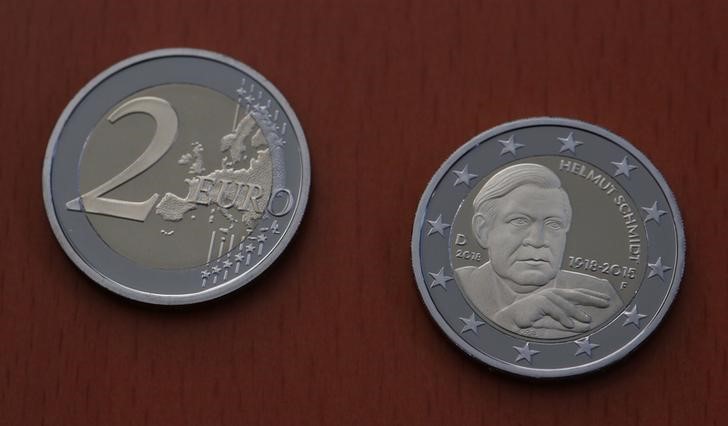 © Reuters. Presentation of a new 2 Euro commemorative coin in honour of former German Chancellor Helmut Schmidt
© Reuters. Presentation of a new 2 Euro commemorative coin in honour of former German Chancellor Helmut SchmidtBy Dhara Ranasinghe
LONDON (Reuters) – German 10-year bond yields hit five-week lows on Wednesday, leading a decline in most euro zone debt yields after news of a slowdown in euro zone business activity cast doubt on the timing of the ECB’s planned exit from its hefty stimulus program.
As risk-off sentiment gripped world markets, peripheral bonds sold off. Growing political risks pushed Italian bond yields to 14-month highs – widening the gap over German Bund yields by 15 basis points.
IHS Markit’s Euro Zone Composite Flash Purchasing Managers’ Index (PMI), considered a good guide to economic health, sank in May to an 18-month low of 54.1 from 55.1, below all forecasts in a Reuters poll, which predicted a dip to 55.0.
That followed weaker-than-expected PMIs in Germany and France, the two biggest euro zone economies, which alongside soft inflation suggested a stiffer policy challenge for a European Central Bank hoping to exit monetary stimulus.
“We had expected some stabilization (in the PMIs). Clearly, we have not seen that, and the deceleration has increased downside risks to Q2 growth, which is a worry,” said Peter Kinsella, senior currency and rates strategist at CBA.
“We had anticipated that the ECB would give us some forward guidance in June. They may put a hold on that or give just a modest form of guidance.”
Ten-year bond yields in the single currency bloc, with the exception of southern Europe, fell 3 to 6 basis points.
Doubt over whether a North Korea summit next month would take place also gave investors another incentive to buy German bonds, considered one of the world’s safest assets. Bund yields fell to 0.496 percent, their lowest level in five weeks ().
But Southern European bonds were hit by new signs of momentum slowing. Portuguese, Italian and Spanish bond yields all rose.
Italy, also whacked in the past week by concern a spendthrift coalition government was taking shape in Rome, looked the most vulnerable. Its 10-year bond yield shot up 2.44 percent () and was last up 11 basis points.
“The PMIs were certainly surprising to us this morning,” said Investec economist Ryan Djajasaputra.
“It now also raises questions over the timing of the next move on the ECB, whether there actually will be a rate hike in the summer of 2019.”
Money market pricing on Wednesday suggested investors were scaling back bets the ECB would raise rates by mid-2019.
The difference between the overnight bank-to-bank interest rate for the euro zone (Eonia) and forward Eonia rates dated for the ECB’s June 2019 meeting was 5.8 basis points on Wednesday, down from 9 bps last week.
Analysts say that means investors are pricing in less than a 60 percent chance of a 10-basis-point increase in the ECB’s deposit rate.
In Italy, focus remained on who will lead the coalition government proposed by the anti-establishment 5-Star and far-right League. On Tuesday, League leader Matteo Salvini said he would like to see eurosceptic economist Paolo Savona as economy minister, unnerving investors.
To view a graphic on euro risk reversals and periphery, click: https://reut.rs/2Lfv8bE
Source: Investing.com




























